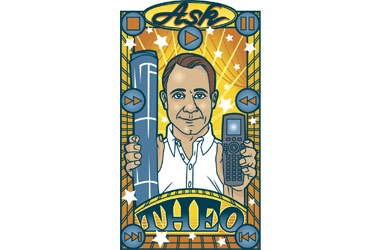Now Playing: The Man Who Invented Home Theater Page 7

THE WORLD'S MOST FAMOUS HOME THEATER DESINGER WANTS TO GIVE YOU A HAND By Theo Kalomirakis
Back in those crazy, insecurity-ridden early days of my career as a self-taught home theater designer, my recurring nightmare was that I would run out of fresh ideas, that somehow my clients would discover that I was incompetent and pull a Donald on me: "You're fired!"
Then, one cold morning in the winter of 1996, my nightmare almost became a reality. I was meeting a new client in his house in Oyster Bay, New York. Construction had just been completed, but the basement was still unfinished. He walked me downstairs to a room marked in the plans as "the theater" - a smallish, rectangular box begging to be turned into something unique and original. Judging by the house's cool, modern architecture and the collection of paintings by some pretty impressive American masters hanging everywhere on its white, gallery-like walls, the client obviously had very good taste. I thought to myself: "Finally - I'm not going to be asked again to come up with another gilded, gaudy copy of some old movie palace." A modernist at heart, I prepared for a new and different kind of challenge.
Not so fast. . . . By the time we started talking business, I did get a challenge, but not exactly the one I had expected. The client said, "I want you to do Radio City Music Hall." To which I responded, "You want what?"
"You heard me."
"Wow! But isn't this room a bit . . . confined for that?"
"It doesn't bother me. And by the way, I have a firm budget, and I'm not spending a penny over it."
"What's the budget?"
"Not counting the electronics, $50,000. Not a penny over it."
Radio City Music Hall for $50,000? Someone was pulling my leg!
"Run, Theo, run!" was my first impulse. But I didn't. I accepted the challenge and designed a theater that echoed - rather than copied - Radio City Music Hall in a miniature scale. When all was said and done, the cost for construction and finishes came to about $49,000. How? By being resourceful rather than throwing money at the problem: drywall instead of millwork, good old paint instead of fancy wall treatments. To camouflage the humble origins of the building materials and to accentuate whatever good ideas were lurking in the design, I used lighting. Yes, lighting is one of the key elements of good design. Using it creatively can divert attention even from the most banal materials.
Bottom line: No matter how lofty the goal is (in the case with the mini Radio City, read "preposterous"), you don't always need the budget of a third-world nation to get results. That's just one of the things I have learned over the years.
Starting with the September issue, I'll be sharing similar lessons with you based on your projects. Send me photos of your finished theater (hey, a little showing off doesn't hurt!) or the plans of the theater you want to build, and I'll tell you honestly what I think. If you don't have plans yet, a sketch or a picture of something that has inspired you will do. Don't expect idle praise. If something doesn't work, you won't have to guess what's on my mind. But if you show me something exciting, I'll be your cheerleader.
If you asked me what advice I'd give to someone who's ready to tackle the design of his or her home theater, I'd say without a doubt: Relish the challenge. Don't let the glossy photos of other people's picture-perfect private theaters intimidate you or make you miserable with envy. Instead, let them inspire you. I call it creative "stealing," and, oh boy, I've lost count of how many times I've "stolen" creatively from my idols in the field of architecture and design. Go ahead: Try something new, try something old, but please, try to also enjoy the process. Design should be fun, not a chore. And when in doubt or afraid that you made or are about to make a big mistake, ask Theo.
Send copies of your photos, plans, or images that inspire you to Sound & Vision, Attn: Theo Kalomirakis, 1256 Broadway, New York, NY 11002. Or send an electronic copy of your submission to soundandvision@hfmus.com and put "Ask Theo" in the subject line.
- Log in or register to post comments



































































